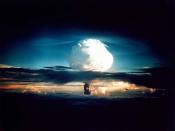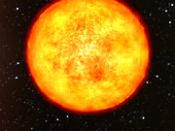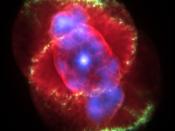Like other stars, the Sun shines by fusing hydrogen into helium in its core. Without the power that this conversion process generates, a star would collapse under its own immense weight. The heavier the star is, the faster it consumes its hydrogen and the sooner it dies. By the time our Sun becomes a senior citizen, most of its hydrogen will be gone and its core will consist of pure helium. With no more hydrogen left at the core, the nuclear reactions that occurred there die out. And helium cannot burn at the low temperatures associated with hydrogen fusion. Without the outward pressure of radiation from the nuclear reactions, the core of the Sun will start to shrink. With the inward crush of matter, the remaining hydrogen around the core heats up enough to begin a new phase of fusion. The radiation produced slowly pushes the outer layers of the Sun out once more.
As the Sun now reaches a critical temperature, helium atoms start to fuse together to form carbon. This reaction halts the collapse of the core, but not for long. Helium burns much faster than hydrogen. The intense heat expels a massive wave of radiation that pushes the Sun's atmosphere out further. Just over 7 billion years from now, the Sun will transform itself into a so-called red giant, 100 times its present size and maybe 2,000 times a luminous. As it continues to expand, its gas thins and clears. Light from the dense core shines through outer layers of gas for the first time. The star is now pulsating from fusion reactions in a helium shell around a carbon core, driving the Sun's outermost layers even farther out into space. They eventually form a glowing sphere called a planetary nebula. The Sun's now carbonized core shrinks...


